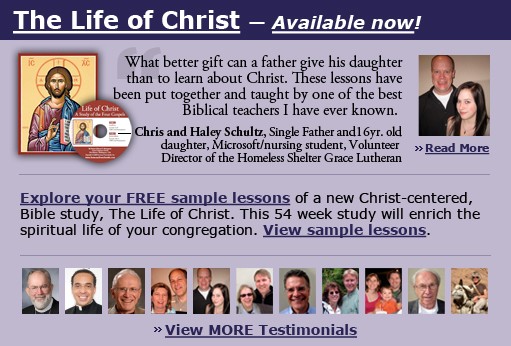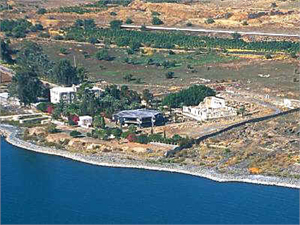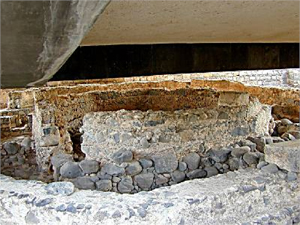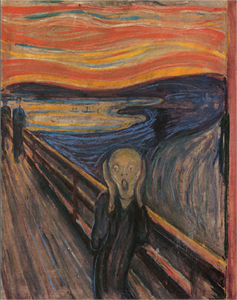
Christmas
Easter
Pentcoest
All Saints
Christ The King
Confirmation
Palm/Passion
Reformation
Stewardship
Books of the Bible
Lenten Series
Christmas Dramas
Videos
Series A - Matthew
Series B - Mark
Series C - Luke
Series D - Other
To contact
Edward F. Markquart
info@sfs.com

Series B Mark 1:29-39 Pastor Edward F. Markquart The following Bible study is from a larger course entitled, THE LIFE OF CHRIST: A Study in the Four Gospels. This 54 week course for the laity will be available for congregations in 2006. Basic text for the course: SYNOPSIS OF THE FOUR GOSPELS, Kurt Aland, English Edition, P. 35-36. THOUGHTS ABOUT THE HEALING MIRACLES OF JESUS Every normal person wants to be well, physically and emotionally. That was true in Jesus’ day; and that is true also today. Mental and physical health has always been important to human beings. Health and healings are signs of the Presence of God and the kingdom of God. When people, societies, and nations are healthy, that is good. Their health is a sign that the Presence of God is with them. But the issue is more complex than that. We also find that God is present during times of illness, suffering, and disease and in the deep valleys and deep shadows of death and dying. In fact, when we are suffering the most, God is with us. Even so, a sign of the kingdom of God is when evil and the demonic is eradicated. Every century and generation formulates its own understanding of diseases, their causes and their cures. Every generation an area of the world has its own particular diseases that are of primary concern. In the Biblical days of the New Testament, it was blindness, leprosy and lameness. Today, our society is concerned about cancer, heart attacks, and alcohol/drug addictions. The new modern plague and pandemic in the world is AIDs. The people of the New Testament generation did not have concepts of viruses, germs, heredity, and environment factors that contribute to the cause of diseases. The New Testament generation simply believed that “sin,” “demons” and “evil spirits” caused diseases. The Old and New Testaments were written in a pre-scientific age. Diseases and illnesses have been regarded as undesirable and evil, regardless of century of those diseases. People of every generation work at getting rid of those illnesses. A high percentage of diseases have always been caused by sinful behaviors and attitudes, by dispositions of the mind and actions of the body. Studies today conclude that 85% of all illnesses that physicians see today are caused by psychological attitudes. One study about cancer prone mice put those mice into a laboratory test. One group of cancer prone mice had enormous stress put on them; the second group was stress free. 92% of the first group of stressed mice developed cancer; 75 of the second group of stress-free mice developed cancer. Stress in mice affected their immune systems at a 92% rate. In other words, people today are well aware that stress and psychological “dis-eases” contribute to physiological diseases. Also, if companies pollute a river with waste that contains carcinogens, people living near that river will have a higher incidence of cancer. Likewise, people will have a higher rate of cancer if they live with asbestos in their homes, live near an aging smokestack, or live near a company that has been polluting the environment. The higher rate of cancer in those situations will be a symptom of sinful decisions and behaviors permeating the environment in which people live. Many people, then and now, often ask the question when they or their loved ones are sick: “Why is God punishing us?” Illness is often seen as a punishment from God. In the Bible, we remember the question: “Is this man blind because his parents sinned or because he sinned?” Many people intuitively and erroneously believe that illness is simply a consequence of sin, an evidence of sinful consequences. The Book of Job was written to counter this simplistic conclusion. That is, there are illnesses which are a result of sinful and foolish behaviors; there are illnesses which are notthe result of sinful and foolish behaviors. It is not simply true that all illness is God’s punishment for sinful behavior. The healing miracles of Jesus have inspired the church in every century to be engaged in the art and science of healing as evidence of the reign of God. Doctors and nurses today are still drawn to the medical professions as a way of helping people. Hospitals are often named after religious figures. According to the Gospels, Jesus was involved in sixteen healing miracles, whereby God, through Jesus and the power of faith, healed people. The Gospel of Mark records ten consecutive incidents at the beginning of his Gospel where Jesus was involved with people being healed of their diseases. These healings were signs that the reign of God was present. In your textbook by Aland, see pages 35-46, #36-48, and quickly look at the sequence of ten stories about healing in the Gospel of Mark. #37 HEALING OF PETER’S MOTHER-IN-LAW Matthew 8:14-15, Mark 1:29-31, Luke 4:38-39 The three synoptic Gospels are parallel and nearly identical. The theory is that Matthew and Luke copied from Mark or John Mark. The story continues in the village of Capernaum.
Aerial View.In existence approximately from 300 BCE to 800 CE, Capernaum was built along the edge of the Sea of Galilee and had up to 1500 residents. Today the ruins are owned by two churches: the Franciscans control the western portion with the synagogue and the Greek Orthodox property is marked by the white church with red domes. -As soon as they left the synagogue, they entered the house of Simon and Andrew, with James and John. We can imagine Jesus leaving the synagogue and walking a short distance to Simon Peter’s house. Highlight the word, “house.” Matthew and Luke have Simon owning the house; Mark implies that both Simon and Andrew own the house. We are going to see this same house on several occasions when Jesus was in Capernaum. See page 36 (Mark 1:33 and “the door”); see page 40 (Mark 1:1); see page 158 (Mark 9:33). Notice that these references to Peter’s house are recorded in the Gospel of Mark. It is Mark’s gospel which records the remembrances of Peter via John Mark. Notice the gospel parallels: Peter’s house and Simon’s house. Matthew and Luke copy from Mark and interpret Mark. The House of Peter: Excavations revealed one residence that stood out from the others. This house was the object of early Christian attention with 2nd century graffiti and a 4th century house church built above it. In the 5th century a large octagonal Byzantine church was erected above this, complete with a baptistery. Ancient pilgrims referred to this as the house of the apostle Peter.
-Now Simon's mother-in-law was in bed with a fever, and they told him about her at once. The fever is not attributed to demon possession but labeled simply a fever. -He came and took her by the hand and lifted her up. Notice the detail. Either Peter (telling this story to John Mark) was crafty in giving the illusion of historical authenticity or Peter was reporting what he had seen that day in his own home. -Then the fever left her, and she began to serve them.Luke adds, “rebuked” the fever, as if Jesus were rebuking a demon inside. #38 THE SICK HEALED AT EVENING Matthew 8:16-17, Mark 1:32-34, Luke 4:40-41 All three accounts are again parallel. - That evening, at sundown, they brought to him all who were sick or possessed with demons. In all three gospel accounts, this event occurs at the end of that same day. Peter, an eyewitness who is telling “his own story,” gives us the exact time of day. Mark is the earliest gospel, having been composed earlier than Matthew and Luke. The Gospel of Mark is the historical recollections of Simon Peter via John Mark. There seems to be a distinction between people who were “sick” and people who were “demon possessed.” Also see Mark 1:34 and highlight: “He healed many who were sick with various diseases and cast out many demons.” Demon possession was a form of mental illness during Biblical times. Demon possession and fear of demons was part of the ancient Biblical world e.g. there was a blindness demon, a leprosy demon, a lameness demon, etc. The people of the ancient Biblical era lived in a world permeated with demons and evil spirits. In this course, “demon possession” will be treated as a form of mental illness/emotional disturbance. A modern painting that symbolizes emotional madness is entitled, The Scream. http://www.edvard-munch.com/Paintings/anxiety/scream_3.jpg Edvard Munch, The Scream
Dr. William Barclay, in his commentary on this text, tells about “trepanning” in the ancient medical world. “Trepanning” was a primitive surgical procedure in which a hole was drilled in a human skull to release the demons inside the skull. Six of more than one hundred skulls found in an ancient cemetery had experienced “trepanning.” We often forget how people with mental illness were treated here in America before drugs were available for their treatment. Before the advent of drugs to control mentally ill people, there were chains attached to the floor of the “insane asylum” like at Hastings State Hospital in Hastings, Minnesota. I worked at Hastings State Mental Hospital as a student-chaplain so many years ago. In the “old days,” prior to drugs, mentally ill patients were chained to the basement walls in this facility, near a cement trench, in which the mentally ill patients could urinate and defecate. The advent of new drugs enabled these people to become freed from their physical chains and even live lives outside of the “insane asylum.” We sometimes forget how the emotionally disturbed were treated in our society before the advent of miracle drugs. Through the advent of “miracle drugs,” the behaviors and language of emotionally unstable people were controlled and these people were released out into normal society. -And the whole city was gathered around the door. We can see the detail. We can imagine all the population of this small town gathered about the door of the home where Jesus was. -And he cured many who were sick with various diseases, and cast out many demons; We again see the distinction between “diseases” and “demons.” -And he would not permit the demons to speak, because they knew him. The demons knew the true identity of Jesus in a way that mere human beings did not. It seems as if Jesus did not want his true and full identity revealed yet. Perhaps human beings would then follow Jesus for the wrong reasons e.g. they would follow Jesus to obtain healings, bread, or political freedom. It was not until the Mount of Transfiguration that Jesus’ true identity was fully revealed in the synoptic gospels. Also, the people of that era were intensely longing for a political messiah to deliver them from their bondage to the Romans. If Jesus was revealed by “insane voices” to be the messiah foretold in the Old Testament, this may cause an uproar of political fervor that Jesus was the longed-for political messiah, that he was a “new David” who would throw off the Roman oppression. This, too, would have been an inaccurate conclusion about Jesus’ true identity. -This was to fulfill what was spoken by the prophet Isaiah. (Matthew only) Matthew is consistent, “This was to fulfill what was spoken by the prophet.” Matthew was persuading his Jewish audience to believe. If Jesus was the fulfillment of all these Jewish prophecies, then Jesus was indeed the long awaited Messiah. #39 JESUS DEPARTS FROM CAPERNAUM Mark 1:35-38, Luke 4:42-43 These are precise parallels between Mark and Luke, with Luke theoretically copying from Mark. - In the morning, while it was still very dark, he got up and went out to a deserted place, and there he prayed. Once again, we can feel the eyewitness account of the event by Simon Peter. It was still very dark. It was then that Jesus got up. Jesus went out to a deserted place where he prayed. -And Simon and his companions hunted for him. Simon Peter is the person who is retelling his Jesus Story to John Mark, and we readers can visualize Simon and the other disciples out searching for Jesus and trying to find him. This is another historical detail. -When they found him, they said to him, "Everyone is searching for you." -He answered, "Let us go on to the neighboring towns, so that I may proclaim the message there also; for that is what I came out to do/for I was sent for this purpose." Highlight this last line. Remember that the kingdom of God is the central theme of Jesus’ ministry in the first three gospels. Jesus is bringing the good news that God can and will rule individual lives, rule communities, rule demons, and even rule nature itself. What people want (but may not know that is what they want) is for God to rule their/our lives. The phrase, “kingdom of God,” does not appear once in the Old Testament but is on the lips of Jesus 82 times in the four gospels. We are going to hear about the parables of the kingdom, listen to the teachings of the kingdom and witness the miracles of the kingdom. We are going to be called to accept the kingdom with the faith/trust as a little child. The kingdom is the most valuable possession that a person can have #40 FIRST PREACHING TOUR IN GALILEE Matthew 4:23, Mark 1:39, Luke 4:44 - And he went throughout Galilee, proclaiming the message in their synagogues and casting out demons. - Jesus went throughout Galilee, teaching in their synagogues and proclaiming the good news of the kingdom and curing every disease and every sickness among the people. (Matthew) Notice the Matthew parallels of teaching, preaching and healing. There were the missions of Jesus’ life, his first disciples, and the church today. |


